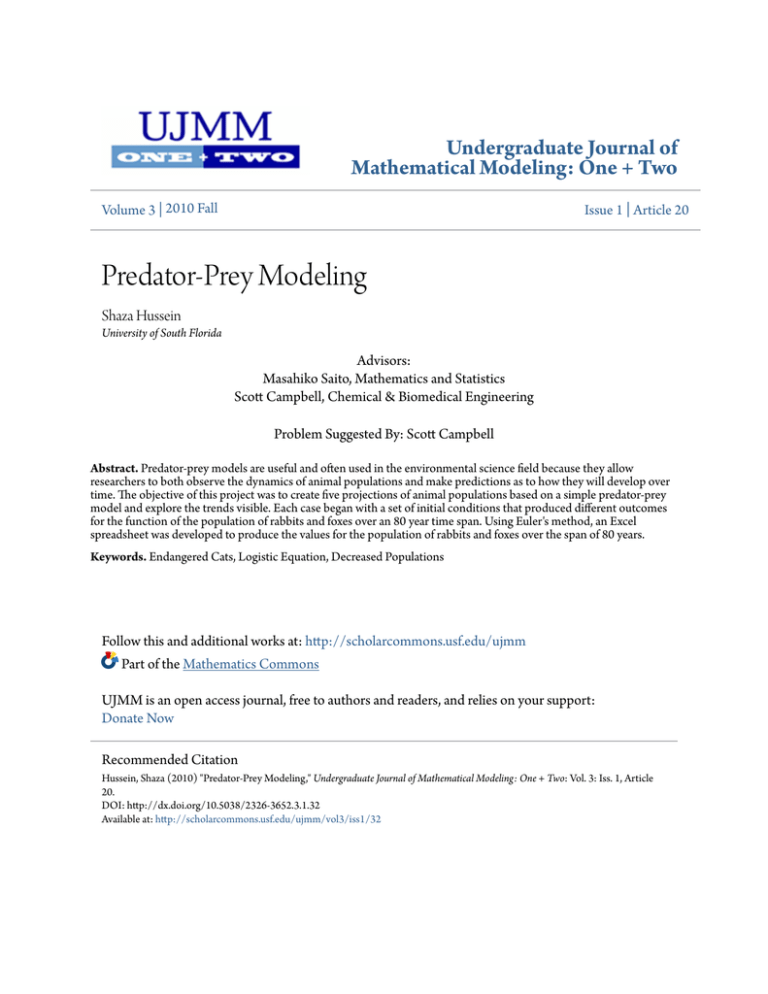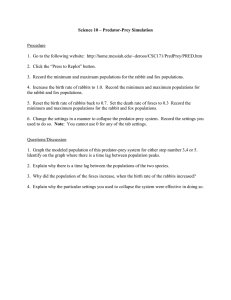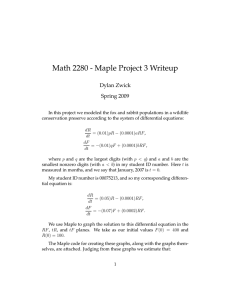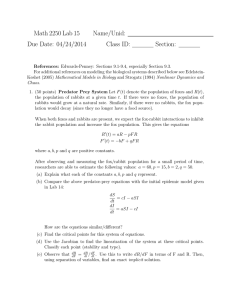Predator-Prey Modeling - Scholar Commons
advertisement

Undergraduate Journal of Mathematical Modeling: One + Two Volume 3 | 2010 Fall Issue 1 | Article 20 Predator-Prey Modeling Shaza Hussein University of South Florida Advisors: Masahiko Saito, Mathematics and Statistics Scott Campbell, Chemical & Biomedical Engineering Problem Suggested By: Scott Campbell Abstract. Predator-prey models are useful and often used in the environmental science field because they allow researchers to both observe the dynamics of animal populations and make predictions as to how they will develop over time. The objective of this project was to create five projections of animal populations based on a simple predator-prey model and explore the trends visible. Each case began with a set of initial conditions that produced different outcomes for the function of the population of rabbits and foxes over an 80 year time span. Using Euler's method, an Excel spreadsheet was developed to produce the values for the population of rabbits and foxes over the span of 80 years. Keywords. Endangered Cats, Logistic Equation, Decreased Populations Follow this and additional works at: http://scholarcommons.usf.edu/ujmm Part of the Mathematics Commons UJMM is an open access journal, free to authors and readers, and relies on your support: Donate Now Recommended Citation Hussein, Shaza (2010) "Predator-Prey Modeling," Undergraduate Journal of Mathematical Modeling: One + Two: Vol. 3: Iss. 1, Article 20. DOI: http://dx.doi.org/10.5038/2326-3652.3.1.32 Available at: http://scholarcommons.usf.edu/ujmm/vol3/iss1/32 Hussein: Predator-Prey Modeling 2 SHAZA HUSSEIN TABLE OF CONTENTS Problem Statement ......................................................................................................... 3 Motivation ........................................................................................................................ 4 Mathematical Description and Solution Approach ............................................... 5 Discussion ........................................................................................................................ 6 Conclusion and Recommendations ........................................................................... 8 Nomenclature ................................................................................................................ 10 References ...................................................................................................................... 10 Appendix ........................................................................................................................ 11 Produced by The Berkeley Electronic Press, 2010 Undergraduate Journal of Mathematical Modeling: One + Two, Vol. 3, Iss. 1 [2010], Art. 32 PREDATOR-PREY MODELING 3 PROBLEM STATEMENT Predator-prey models are used by scientists to predict or explain trends in animal populations. The goal of this project is to explore the behavior of a simple model. Consider a population of foxes, the predator, and rabbits, the prey. Let time and refer to the number of foxes at any refer to the number of rabbits. A simple predator-prey model assumes: Prey birth rate is proportional to the size of the population. Prey death rate is proportional to the size of both the predator and prey populations. Predator birth rate is proportional to the sizes of both the predator and prey populations. Predator death rate is proportional to the size of the predator population. Using the population balance equation: Rate of Change of a Population = Birth Rate – Death Rate the following model can then be derived: where the ’s and ’s are constants obtained from field data. Since these are first order differential equations, they require one initial condition each. These initial conditions will be that the rabbit and fox populations and at time zero. Here we take the constants to have these values: a) Are there any values for http://scholarcommons.usf.edu/ujmm/vol3/iss1/32 DOI: http://dx.doi.org/10.5038/2326-3652.3.1.32 and that will lead to a totally stable set of populations? Hussein: Predator-Prey Modeling 4 SHAZA HUSSEIN b) Set up an Excel spreadsheet to solve the two differential equations using a first order Euler method. Use a step size of years and run for years. Apply it to the following five cases (Table 1), each of which is a different set if initial conditions. CASE STARTING POPULATIONS RABBITS FOXES 1 100 1000 2 1000 100 3 520 180 4 520 220 5 500 200 Table 1: We consider the changes in the populations of rabbits and foxes over an 80 year time period beginning with these five different starting populations. MOTIVATION Predator-prey models are popular in the environmental industry due to their ability to mathematically predict animal populations as well as explain trends that can be observed in species population and density. This mapping out of populations is greatly beneficial because it allows for scientists to track ecosystems and biodiversity. By observing the stability of a predator-prey relationship over time one can measure the strength and stability of the ecosystem itself. Having the knowledge on the way an ecosystem functions, one can then observe the affects and changes the human population has on the ecosystems survival. Numerous predatorprey models exist that vary in complexity and structure. Models can also be specialized to particular regions and populations to ensure accuracy. One particular method, known as Euler’s method, incrementally approximates the solution to two differential equations using first order Produced by The Berkeley Electronic Press, 2010 Undergraduate Journal of Mathematical Modeling: One + Two, Vol. 3, Iss. 1 [2010], Art. 32 PREDATOR-PREY MODELING 5 derivatives starting from initial conditions. The increments we use are small to insure high accuracy. Altering the initial conditions offers several outlines of population trends over years. We can then take this data and draw conclusions as to the patterns and trends of each particular population scenario. MATHEMATICAL DESCRIPTION AND SOLUTION APPROACH Euler’s method is a first order numerical procedure for approximating differential equations given an initial value. In this method the exact solution is unknown but the first order derivatives are known. In this case, (1) (2) R and F are the number of rabbit and foxes, which are present at any given time t. The and values, are constants obtained from field data. Here we were given the values of these constants as listed below: (3) We first explore if there are initial population values which lead to stable populations of both rabbits and foxes. This is determined by setting both equations (1) and (2) equal to zero and solving for the values of R and F, because a stable population will have a constant rate of change, i.e., and , which is equal to zero. This means (4) and . http://scholarcommons.usf.edu/ujmm/vol3/iss1/32 DOI: http://dx.doi.org/10.5038/2326-3652.3.1.32 (5) Hussein: Predator-Prey Modeling 6 SHAZA HUSSEIN Note both equations are satisfied when either and or and . Since the first solution is trivial, we will focus on the second solution. We now turn our attention to constructing an Excel spreadsheet to use the first order Euler’s method to solve the two differential equations. The Euler method provides values of future rabbit population values by taking the previous population value and adding the previous value multiplied by a small value of ; the same is done for the values of . This is shown as (6) . First, the initial values of and (7) for each particular case were put in the tables. Then, equations (6) and (7) were used to generate new values. Next, the new values of and were computed using equations (1) and (2). Once all the values were computed for each case, the values for and were plotted against the values for time. See the Appendix for the resulting graphs. DISCUSSION The objective of this project was to create five projections of animal populations based on a simple predator-prey model and explore the trends visible. Each case began with a different set of initial conditions that in turn dictated how the populations changed over time. See Table 1 for a list of the cases and the Appendix for the graphs corresponding to each case. In case 1, we started with a rabbit population, prey, of 100 and a predator population, foxes, of 1000. As can be seen from figure 1 the change in population is periodic for this case. The rabbit population can be seen to be related to the fox population, as it grows one can predict to see an increase in the fox population will follow. This trend seems plausible since the population of foxes in the first order differential is dependent on the population of its food Produced by The Berkeley Electronic Press, 2010 Undergraduate Journal of Mathematical Modeling: One + Two, Vol. 3, Iss. 1 [2010], Art. 32 PREDATOR-PREY MODELING 7 source, the rabbits. It is also seen that the rabbit population depends on that of the fox. The cycle begins with a decline in the fox population. This decline continues until the fox population is drastically low and correlates with an increase in the rabbit population. From the graph this rise and fall of populations seems to occur in thirty year increments and the populations values look to be near equal at values near 1250 members per population. In case 2, we started with a rabbit population of 1000 and a fox population of 100. Figure 2 shows that this model also provides a periodic population density where a decline in prey correlates with decline in predator. This cycle however occurs in shorter twenty year increments. Figure 2 shows an initially high population of rabbits that declines as the fox population increases. The relative maximums in the fox population on this graph are also the points of intersection between the two population functions. This point of intersection seems to increase over time, beginning at approximately 600 and increasing by about 50 members each cycle. In case 3, we started with an initial rabbit population of 520 and a fox population of 180. Figure 3 shows that this model differs from the previous but still follows a periodic trend. The peeks in rabbit populations are followed by peeks in the fox population approximately five years later. The same can be said for general increases and decreases in rabbit population that occurs through the 80 year time span. The total peek to peek cycle for both the rabbit and fox population is roughly twenty years. This model provides for a more stable population than the previous two as the values stay within a particular range, 450 - 550 for the rabbits and 150 – 250 for the foxes, and there are now extreme rise and fall scenarios. The two populations however never intersect, though the relatively stable population lends some knowledge to what may be the numerical relationship between the rabbit and fox populations. http://scholarcommons.usf.edu/ujmm/vol3/iss1/32 DOI: http://dx.doi.org/10.5038/2326-3652.3.1.32 Hussein: Predator-Prey Modeling 8 SHAZA HUSSEIN In case 4, we started with an initial rabbit population of 520 as well and an initial fox population of 220. This model is very similar to case three, with closely corresponding values for range and nearly identical periodicity. The fox population though begins with an initial decrease in this scenario versus the initial increase that occurs in case 3. The minimums in the fox population follow the minimums in the rabbit population on a five year delay. This case also leads to moderately stable populations that do not intersect and lend knowledge to what the values could provide completely stable populations. The range for rabbit population values is between 450 and 550 while the range of fox values is between 150 and 250, just as before. In the final case, case 5, we used the values to calculate the part in which to prove that a stable population is in fact possible with those values. Granting no external influences the values of and provide fully stable populations that are merely straight lights at those particular values. Figure 5 shows that there are theoretically no changes in the population of either the rabbits or foxes over the 80 year time span. CONCLUSION AND RECOMMENDATIONS Over all these various scenarios, using the Euler method, certain overriding trends can be seen. The graph and figures support the notion that the rabbit population and fox population are codependent on one another. The graphs show a correlation between the two populations rises and falls in all cases indicating that , all other conditions constant, the number of rabbit present at any moment is related to the number of foxes present at any moment and vice versa. The periodicity of the population depends on the initial values but is regular and consistent in all cases. Produced by The Berkeley Electronic Press, 2010 Undergraduate Journal of Mathematical Modeling: One + Two, Vol. 3, Iss. 1 [2010], Art. 32 PREDATOR-PREY MODELING 9 These conclusions are all contingent upon several assumption made at the beginning of the experiment. We assume that the parameters under which we made our differential equations for the rabbit and fox populations were correct and necessary. This is pivotal because we must be able to state that the equations that we base or experiment on are correct and apply properly to this situation. The other assumption is that our value of is small enough to work using the Euler Method. Euler’s method uses approximation based on the previous values of and and therefore makes it’s approximates in small leaps. Since Euler’s method depends heavily on making ones choice of small enough to allow for consistent and reliable predictions, then perhaps future studies could make the value of variable rather than the initial values of the and . This would allow for one to compare various models with same conditions to see is different, smaller or larger, values of would provide with different models of population. This study could either further validate or discredit the values from this study because our conclusion are contingent upon the assumption that our value for was small enough to produce accurate predictions. http://scholarcommons.usf.edu/ujmm/vol3/iss1/32 DOI: http://dx.doi.org/10.5038/2326-3652.3.1.32 Hussein: Predator-Prey Modeling 10 SHAZA HUSSEIN NOMENCLATURE Symbol Description Units Population of Rabbits Population of Foxes Time Birth Rate of Rabbits Death Rate of Rabbits Birth Rate of Foxes Death Rate of Foxes REFERENCES Xiao, Yanni, Yanni Xiao and Lansun Chen. Modeling and Analysis of a Predator – Prey Model with Disease in the Prey. Institute of Mathematics, Academy of Mathematics and System Sciences. Academia Sinica, Beijing 100080, People’s Republic of China : Mathematical Biosciences Volume 171, Issue 1, May 2001, Pages 59-82. Produced by The Berkeley Electronic Press, 2010 Undergraduate Journal of Mathematical Modeling: One + Two, Vol. 3, Iss. 1 [2010], Art. 32 PREDATOR-PREY MODELING 11 APPENDIX - FIGURES 3000 Rabbit Population Fox Population 2500 Population 2000 1500 1000 500 0 0 10 20 30 40 50 60 70 80 Time (t-years) Figure 1: Rabbit and fox populations over an 80 year span starting with 100 rabbits and 1000 foxes. 3000 Rabbit Population Fox Population 2500 Population 2000 1500 1000 500 0 0 10 20 30 40 50 60 70 Time (t-years) Figure 2: Rabbit and fox populations over an 80 year span starting with 1000 rabbits and 100 foxes. http://scholarcommons.usf.edu/ujmm/vol3/iss1/32 DOI: http://dx.doi.org/10.5038/2326-3652.3.1.32 80 Hussein: Predator-Prey Modeling 12 SHAZA HUSSEIN 3000 Rabbit Population Fox Population 2500 Population 2000 1500 1000 500 0 0 10 20 30 40 50 60 70 80 Time (t-years) Figure 3: Rabbit and fox populations over an 80 year span starting with 520 rabbits and 180 foxes. 3000 Rabbit Population Fox Population 2500 Population 2000 1500 1000 500 0 0 10 20 30 40 50 60 70 Time (t-years) Figure 4: Rabbit and fox populations over an 80 year span starting with 520 rabbits and 220 foxes. Produced by The Berkeley Electronic Press, 2010 80 Undergraduate Journal of Mathematical Modeling: One + Two, Vol. 3, Iss. 1 [2010], Art. 32 PREDATOR-PREY MODELING 13 3000 Rabbit Population Fox Population 2500 Population 2000 1500 1000 500 0 0 10 20 30 40 50 60 70 Time (t-years) Figure 5: Rabbit and fox populations over an 80 year span starting with 500 rabbits and 200 foxes. http://scholarcommons.usf.edu/ujmm/vol3/iss1/32 DOI: http://dx.doi.org/10.5038/2326-3652.3.1.32 80


